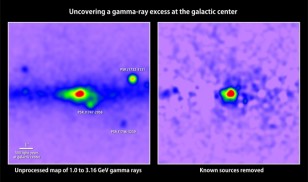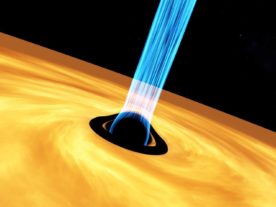
Artist rendering of the Fermi Gamma-ray Space Telescope. (NASA)
Scientists believe high-energy gamma rays emanating from the center of our Milky Way are being produced by dark matter, the mysterious hypothetical substance believed to make up most of the physical universe.
A new study based on independent research of gamma ray light shows that the center of our galaxy is cranking out huge amounts of these light emissions.
Gamma ray emissions are thought to be normally produced by sources such as interacting binary star systems (solar systems with two stars), isolated pulsars (rotating neutron stars), remnants of supernovae (exploding stars) and particles colliding with interstellar gas.
However, scientists have deduced other sources must be contributing to the massive output.
The researchers involved with the study, including scientists from NASA and Stanford and Harvard universities, believe this excess gamma radiation could be produced by dark matter.

A map of gamma rays detected in the galactic center by the Fermi Space Telescope. Red indicates the greatest number emissions. Prominent pulsars are labeled (left). Removing all known gamma-ray sources (right) reveals excess emission that may arise from dark matter annihilations. (T. Linden, Univ. of Chicago)
“The new maps allow us to analyze the excess and test whether more conventional explanations, such as the presence of undiscovered pulsars or cosmic-ray collisions on gas clouds, can account for it,” said Dan Hooper, an astrophysicist at Fermilab in Batavia, Ill., and a lead author of the study. “The signal we find cannot be explained by currently proposed alternatives and is in close agreement with the predictions of very simple dark matter models.”
The scientists subtracted already known gamma ray sources from the amount of the high energy radiation coming out of the galactic center and found a remaining patch of leftover emissions (see photo right).
“This study is an example of innovative techniques applied to Fermi data by the science community,” said Peter Michelson, a Stanford University physics professor and the principal investigator for the Large Area Telescope (LAT), the principal scientific instrument on the Fermi Gamma Ray Space Telescope spacecraft. “The Fermi LAT Collaboration continues to examine the extraordinarily complex central region of the galaxy, but until this study is complete we can neither confirm nor refute this interesting analysis.”
While dark matter provides a convenient explanation for the gamma ray excess, the researchers point out it will take further investigation to confirm the role dark matter plays in the production of the excess gamma radiation. They also note continued research could reveal other possible alternative sources of the gamma rays that do not require dark matter.
This animation zooms into an image of the Milky Way, shown in visible light, and superimposes a gamma-ray map of the galactic center from NASA’s Fermi. Raw data transitions to a view with all known sources removed, revealing a gamma-ray excess hinting at the presence of dark matter. (NASA Goddard; A. Mellinger, CMU; T. Linden, Univ. of Chicago)




















Comments are closed.